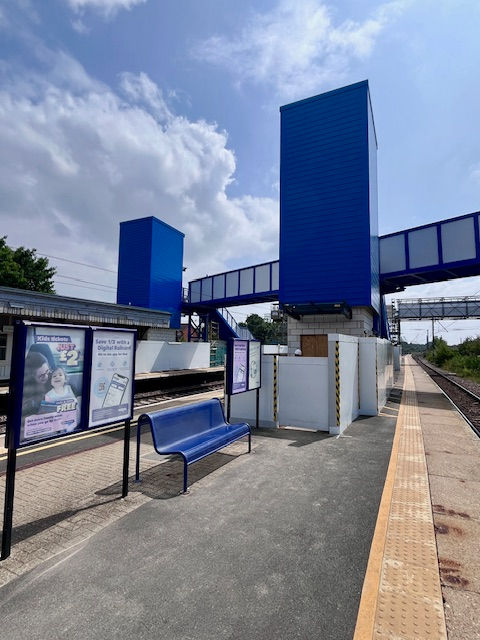A decade of step-free delay
- Julian Vaughan

- Aug 9, 2024
- 5 min read
In 2015, Sir Peter Hendy, now Lord Hendy and currently Minister of State for Rail, was appointed as Chair of Network Rail and tasked to conduct a review of the enhancement programme for Control Period 5, which ran from 2014-2019. From the resulting ‘Hendy Report’ this programme was “prioritised to reflect the government’s commitments to maximise passenger and freight user benefits” in light of issues with increased costs and deliverability. As a result, funding for ‘Access for All’ projects to deliver step-free railway stations was cut from £135m to £87.1m and 27 stations had their funding deferred until Control Period 6, 2019 – 2024.
This blog examines what progress has been made at these stations. In summary, of the 27 stations awarded funding in 2014, only 9 have been completed, with a further 8 due to be completed within the next six months or so (so by early 2025) and 10 stations either have no estimate of the completion date, a completion date of mid-2025 or beyond and in some cases it has been impossible to get any reliable information.
The time taken to research this information was lengthened considerably by the significant errors and discrepancies in the station information provided to the public by the rail industry, which are the ‘National Rail Map’, launched with great fanfare in April 2019 by the Rail Delivery Group, and the ‘National Rail Enquiries’ website. I contacted the relevant Train Operating Companies to ask them to correct their information. Some acknowledged their mistake and corrected it, some (I’ll name and shame later) corrected their information, but without acknowledging their error or taking the courtesy to respond.
Providing accurate information really is the easy stuff, but the rail industry seems intent on making its database of station information as inaccurate as the UK rail network is inaccessible.
Following the completion of the research into the 27 stations deferred by the Hendy Report, I also looked at the stations that were not deferred and I include a table of progress further down this blog.
The results make for grim reading, and some stations will be waiting for well over a decade following their original funding was agreed. It is continually the case that when cuts are made, the first cuts are made to accessibility projects. Further, Network Rail does not seem to have learned the lessons on effective project management discussed back in 2015.
Railway Stations deferred from CP5 2014-2019 to CP6 2019-2024
*Updated 9th September 2024
Misinformation
As I mentioned earlier, the time taken to research the above table was increased by the amount of conflicting information between the two main public facing databases for UK railway station information, the National Rail Access Map and the National Rail Enquiries station database – sometimes labelled somewhat disingenuously as ‘Stations made Easy’. There was conflicting information (stating there were lifts at the station when there are not) at the following stations: Cathays, Garforth, Grays, Hither Green, Llanelli, Peckham Rye, Queen’s Park, Seven Sisters, Southend East, Theale, Trefforest, Warwick, Weston-Super-Mare and Worcester Shrub Hill.
Following me highlighting these discrepancies in a lengthy twitter thread which you can find below, all of the station descriptions in the National Rail Map have now been corrected. Clearly some in the rail industry do read my social media, although I have to say most train operating companies did not give me the courtesy of acknowledging either my work, or their error. Many thanks to Southeastern, Transport for Wales and West Midlands Railway for getting in touch. Unfortunately, Great Western Railway, c2c, Southern, Northern, Chiltern and London Overground did not. I realise it is probably a personal failing of mine for getting a bit irked by this, but I wonder what a consultancy would charge the Train Operating Companies for the work I have done for nothing.
Twitter thread 16th July
Just one example of the misinformation is Grays station, managed by c2c, where the station was described as having lifts although none are actually present. Further, the station does not have an accessibility categorisation as mandated by the Office of Rail and Road’s Accessible Travel Policy guidance. Well, it does, but the categorisation does not appear on either the National Rail Enquiries website, or the National Rail Map. Instead, it is buried under their FAQs section of their website, where it states it is a Category B station. Misleadingly, the description of accessibility at the station that they do provide, suggests that it is a Category A station. A link to my Twitter/X thread giving more detail on this here: https://x.com/julian_vaughan_/status/1820794330056966443
Grays station, Essex – managed by c2c

Original description of Grays railway station

Amended description of Grays station
So, what happened to the stations that were not deferred and were due to have step-free routes by 2019, the end of Control Period 5? The data on these stations is set out below and it is a bit of a mixed bag.
Stations awarded Access for All funding for Control Period 5 (2014-2019)
As it stands there remain a sizeable number of stations awarded funding for step-free access a decade ago, that today remain no-go areas for disabled people, people with restricted mobility and parents with young children. This is completely unacceptable.
Meanwhile, Network Rail continues to fail disabled people with poor project management, and judging by the number of project leads for my local step-free schemes in Bedfordshire, what seems to be a serious staff retention problem.
The lack of attention to detail around accessibility information is a symptom of the rail industry’s approach and of a culture where all the right things are said, but not followed up with actions. A tangible example of this culture is the decision of the Office of Rail and Road to remove any regulatory targets for Network Rail around ‘Accessibility’, instead leaving it to ‘assurance monitoring’. For clarity Network Rail has regulatory targets for almost every other aspect of their performance. I have included details of these targets in the ‘further reading’ section below. Rail industry bosses always talk about accessibility being a top priority. However, removing accessibility as a Key Performance Indicator and the lack of any target to indicate success or failure is a clear indication that it is not. There do not appear to be any consequences for failure. I hope the new Labour government will change this.
Reading Lord Hendy’s 2015 report and then listening to the top brass from Network Rail and the Department for Transport during their April 2024 appearance in front of the House of Commons Public Accounts Committee, I’m not clear that any lessons have been learned. They need to learn them fast; disabled people have waited long enough.
An accessible rail network intersects with numerous Labour values such as social justice, the drive to net zero, improving access to work, tackling congestion on our roads and reducing isolation and loneliness across our communities. Not only is a step-free rail network morally the right thing to do, but it also makes economic sense, and the proven economic return will only increase as our population ages.
It is clear we need a culture change within the rail industry, and this must be driven by making accessibility improvements a timebound legal requirement. We have legal targets for net zero carbon, we should have a legal target for making our rail network accessible too.
Julian Vaughan
8th August 2024
Sources and Further Reading
National Rail Access Map (launched by the Rail Delivery Group in 2019) https://accessmap.nationalrail.co.uk/
National Rail Enquiries – station information: https://www.nationalrail.co.uk/find-a-station/
Network Rail: Access for All Programme: https://www.networkrail.co.uk/communities/passengers/station-improvements/access-for-all-improving-accessibility-at-railway-stations-nationwide/
Office of Rail and Road: PR23 final determination – consolidated list of decisions: https://www.orr.gov.uk/sites/default/files/2023-11/05-pr23-final-determination-consolidated-list-of-decisions_1.pdf
Network Rail CP7 Delivery Plan: Consolidated CP& Outcomes forecasts and targets 2024-2029: https://www.networkrail.co.uk/wp-content/uploads/2024/04/CP7-regulatory-outcomes-targets-and-forecasts.pdf
Access for All Benefit Research: Steer Davies Gleave https://uk.steergroup.com/sites/default/files/2021-03/Access4AllBenefitResearch2015.pdf
The Hendy Report Enhancements Delivery Plan Update – January 2016 (170 page draft) https://www.railwaysarchive.co.uk/documents/NR_EnhancementsDeliveryPlanUpdate2016.pdf
Leonard Cheshire: Get on Board 2020 – the economic case for an accessible rail network: https://www.leonardcheshire.org/get-involved/campaign-us/accessible-trains
Alexandra Palace step-free update the “icing on the cake” – December 2014 article in local paper: https://www.thetottenhamindependent.co.uk/news/11672447.alexandra-palace-step-free-access-the-icing-on-the-cake/
Cardiff: Disabled people’s 20 year fight for step-free access https://www.bbc.co.uk/news/uk-wales-65348813






Comments